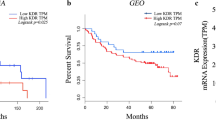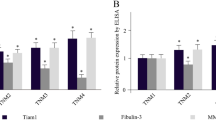Abstract
Oral squamous cell carcinoma (OSCC) is a world-wide health problem and its incidence accounts for 1.9–3.5% of all malignant tumors. Transforming growth factor beta/Smads (TGF-β/Smads) signaling pathway plays an important role in oncogenesis, but its function and molecular mechanisms in OSCC remain unclear. Expression of transforming growth factor-β receptor type II (TβRII) and Smad4 was studied by immunohistochemistry in 108 OSCC patients and 10 normal controls. Function and molecular mechanisms of TGF-β/Smads signaling pathway was then investigated in two human tongue squamous carcinoma cell lines with high and low metastasis (Tb and Tca8113) by RT-PCR, Western Blot, immunofluorescence, cell growth curve and flow cytometry (FCM), respectively. TβRII and Smad4 were significantly down-regulated in tumor tissues (with or without lymph node metastasis) compared to normal oral epithelium tissues (P < 0.05). TGF-β1 induced arrest of the cell cycle rather than cell death in Tca8113 and Tb cells, and this influence was mediated by the increasing the expression and changing the location of its downstream components of TGF-β1/Smads signaling pathway. TGF-β1 rapidly increased the expression of p15 and p21 in both Tca8113 and Tb cells. TGF-β1 did not increase p27 expression in Tca8113 cells, but p27 expression was increased in Tb cells. These indicated that TGF-β1 induced G1 arrest of cell cycle through a different regulating pathway in Tb cells compared with Tca8113 cells. Thus, we conclude that TGF-β/Smads signaling pathway play a important role on cell growth and metastasis potential in OSCC.






Similar content being viewed by others
References
Chen SW, Wen YM, Li LJ, Wang CM, Liao XL (2003) Transfection of the nm23-H1 gene into BcaCD885 cell line inhibits the potential of invasion, adhesion and mobility. ZhongHua Kou Qiang Yi Xue Za Zhi 38:16–19
Nakao A et al (1997) TGF-beta receptor-mediated signalling through Smad2, Smad3 and Smad4. Embo J 16(17):5353–5362
Derynck R, Zhang Y, Feng XH (1998) Smads: transcriptional activators of TGF-beta responses. Cell 95(6):737–740
Rooke HM, Crosier KE (2001) The Smad proteins and TGF-β signaling: uncovering a pathway critical in cancer. J Pathol 33:73–84
Chen T et al (2001) Novel inactivating mutations of transforming growth factor-beta type I receptor gene in head-and-neck cancer metastases. Int J Cancer 93(5):653–661
Wang D et al (1997) Mutation and downregulation of the transforming growth factor beta type II receptor gene in primary squamous cell carcinomas of the head and neck. Carcinogenesis 18(11):2285–2290
Muro-Cacho CA et al (2001) Defective transforming growth factor beta signaling pathway in head and neck squamous cell carcinoma as evidenced by the lack of expression of activated Smad2. Clin Cancer Res 7(6):1618–1626
Kim SK et al (1996) DPC4, a candidate tumor suppressor gene, is altered infrequently in head and neck squamous cell carcinoma. Cancer Res 56(11):2519–2521
Paterson IC et al (2001) Decreased expression of TGF-beta cell surface receptors during progression of human oral squamous cell carcinoma. J Pathol 193(4):458–467
He R (1998) The establishment and some biological characteristics of a squamous cell cancer cell line of the human tongue (Tca 8113). Tumor 3:211–216 (Chinese)
Wu J, Chen J, Li F (1999) Establishement of a metastatic cell line from brain metastasis induced by injection of tongue cancer Tca8113 cells in nude mouse. J Pract Stomatol 15:452–453
Sobin LH, Wittekind C (eds) (1997) UICC TNM classification of malignant tumors, 5th edn. Springer-Verlag, Berlin
Pindborg JJ, Reichart PA, Smith CJ, Van der waal I (1997) Histological typing of cancer and precancer of the oral mucosa. Springer-Verlag, Berlin
Jin XM, Li JR, Li YX, Li ZB (2002) Effect of TGF-β1 on malignant phenotype of oral squamous carcinoma. LinChuang Kou Qiang Yi Xue Za Zhi 18:174–176 (Chinese)
Hebert CD, Birnbaum LS (1989) Lack of correlation between sensitivity to growth inhibition and receptor number for transforming growth factor beta in human squamous carcinoma cell lines. Cancer Res 49(12):3196–3202
Ichijo H, Momose F, Miyazono K (1990) Biological effects and binding properties of transforming growth factor-beta on human oral squamous cell carcinoma cells. Exp Cell Res 187(2):263–269
Iamaroon A, Pattamapun K, Piboonniyom SO (2006) Aberrant expression of Smad4, a TGF-beta signaling molecule, in oral squamous cell carcinoma. J Oral Sci 48:105–109
Chiao PJ et al (1999) Tumor suppressor gene Smad4/DPC4, its downstream target genes, and regulation of cell cycle. Ann N Y Acad Sci 880:31–37
Xu X et al (2000) Haploid loss of the tumor suppressor Smad4/Dpc4 initiates gastric polyposis and cancer in mice. Oncogene 19(15):1868–1874
Natsugoe S et al (2002) Smad4 and transforming growth factor beta1 expression in patients with squamous cell carcinoma of the esophagus. Clin Cancer Res 8(6):1838–1842
Xiangming C et al (2001) Preserved Smad4 expression in the transforming growth factor beta signaling pathway is a favorable prognostic factor in patients with advanced gastric cancer. Clin Cancer Res 7(2):277–282
Ijichi H et al (2001) Systematic analysis of the TGF-beta-Smad signaling pathway in gastrointestinal cancer cells. Biochem Biophys Res Commun 289(2):350–357
Subramanian G et al (2004) Targeting endogenous transforming growth factor beta receptor signaling in SMAD4-deficient human pancreatic carcinoma cells inhibits their invasive phenotype1. Cancer Res 64(15):5200–5211
Feng XH et al (2002) Direct interaction of c-Myc with Smad2 and Smad3 to inhibit TGF-beta-mediated induction of the CDK inhibitor p15(Ink4B). Mol Cell 9(1):133–143
Malliri A et al (1996) Sensitivity to transforming growth factor beta 1-induced growth arrest is common in human squamous cell carcinoma cell lines: c-MYC down-regulation and p21waf1 induction are important early events. Cell Growth Differ 7(10):1291–1304
Peng B et al (2002) Suppression of tumorigenesis and induction of p15(ink4b) by Smad4/DPC4 in human pancreatic cancer cells. Clin Cancer Res 8(11):3628–3638
Jonson T et al (2003) Pancreatic carcinoma cell lines with SMAD4 inactivation show distinct expression responses to TGFB1. Genes Chromosomes Cancer 36(4):340–352
Sirard C et al (2000) Targeted disruption in murine cells reveals variable requirement for Smad4 in transforming growth factor beta-related signaling. J Biol Chem 275(3):2063–2070
Fink SP et al (2001) Transforming growth factor-beta-induced growth inhibition in a Smad4 mutant colon adenoma cell line. Cancer Res 61(1):256–260
Petritsch C et al (2000) TGF-beta inhibits p70 S6 kinase via protein phosphatase 2A to induce G(1) arrest. Genes Dev 14(24):3093–3101
Acknowledgements
We thank all sample donors for taking part in this study. This work is supported by the National 973(2001CD510300) projects and 863(2002BA711A08) projects and Heilongjiang province natural science fund (D-0326) projects of China; Heilongjiang province natural science fund (D2007-01); post-doctoral grant of HeiLongJiang Province (LRB05-279).
Author information
Authors and Affiliations
Corresponding author
Additional information
Xiumei Wang, Wenjing Sun, and Jing Bai contributed equally to this paper.
Rights and permissions
About this article
Cite this article
Wang, X., Sun, W., Bai, J. et al. Growth inhibition induced by transforming growth factor-β1 in human oral squamous cell carcinoma. Mol Biol Rep 36, 861–869 (2009). https://doi.org/10.1007/s11033-008-9256-x
Received:
Accepted:
Published:
Issue Date:
DOI: https://doi.org/10.1007/s11033-008-9256-x




